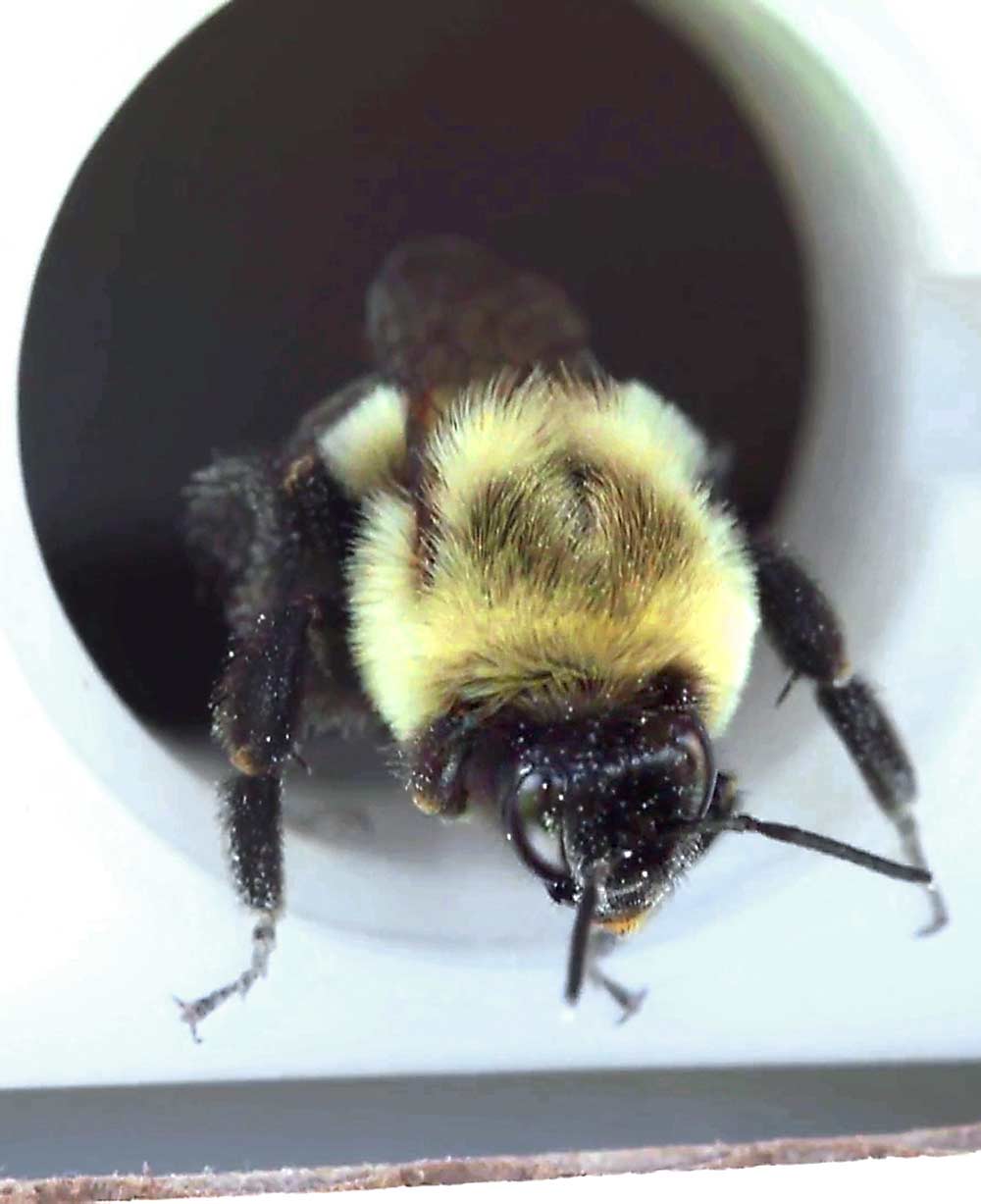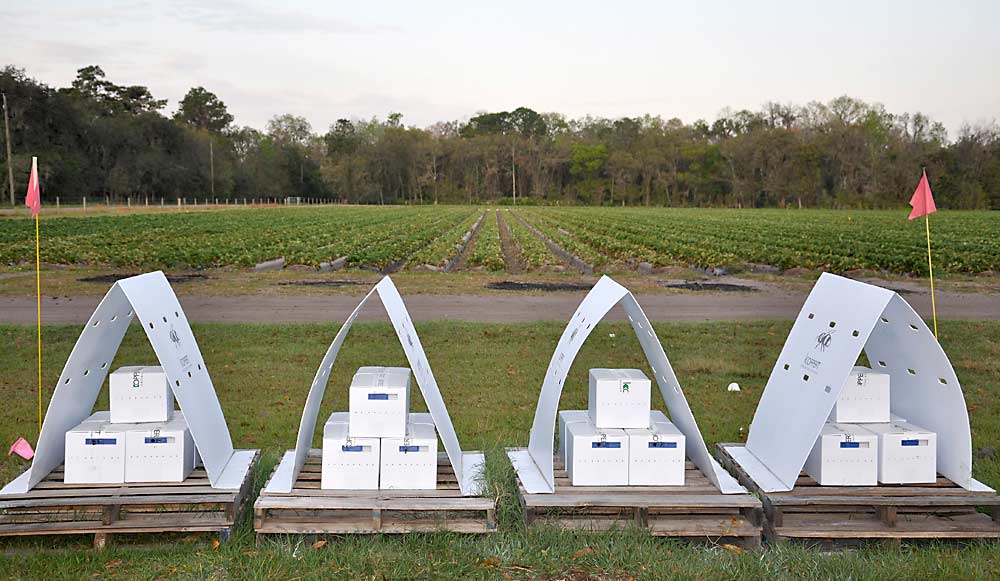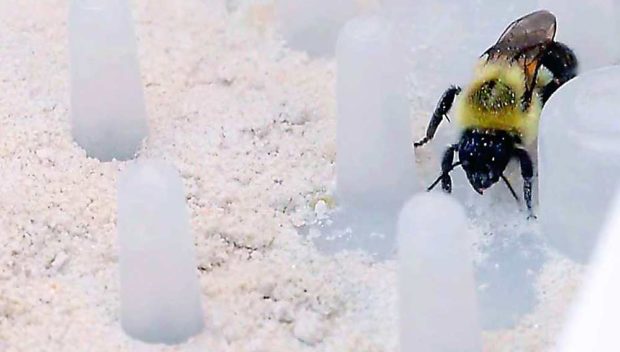For organic blueberry growers, controlling mummy berry remains a challenge. Pollinators carry the fungal pathogen, Monilinia vaccinii-corymbosi, and infect flowers, but the bell shape of the blooms makes it near impossible to spray protective fungicides to the right spot.
That’s why blueberry researcher Tom Walters decided to try a new technology that harnesses the very pollinators that can spread the pathogen to help to control it. Bee vector technology — developed by a Canadian company of the same name — uses bees to deliver a powdered form of a beneficial fungus directly to blossoms, where it acts as a competitor to decay pathogens such as monilinia and botrytis.
“I’m enthusiastic about the fact that they’ve developed a means of delivering their product to the exact right place on the blueberry plant,” said Walters, who runs Walters Ag Research and serves as a consultant to berry growers in Western Washington. He set up a trial using the technology, funded by the company, at a commercial blueberry farm in Whatcom County, Washington.

At press time, Walters didn’t yet have data on effectiveness, but he was already impressed with the ease of the delivery method: Small trays of powdered product are placed at the hives’ exits, forcing the bees to pick up the powder on their legs before they fly toward flowers. Refilling the powder once a week while hives are stocked during bloom is far easier than the intensive spray program organic berry growers deploy with only moderate success, Walters said.
More data on BVT’s performance comes from strawberry fields in Florida, where the pathogen of concern is botrytis, said the company’s CEO, Ashish Malik.
Trials by University of Florida strawberry pathologist Natália Peres show the BVT system boosts yields by about 20 percent — which may be simply a benefit of extra pollination, since bees are not usually stocked in self-fertile strawberry fields — and provides enough disease control to interest organic growers.
“The conventional standard fungicide is better, but we have an increasing number of organic growers who have been looking for options to control botrytis, so they were particularly interested in this technology,” Peres said.
Several strawberry growers in Florida also purchased the technology through a pilot launch last season, according to the company.

In Florida strawberries and a recent trial in Georgia blueberries, BVT uses bumblebees. The company designed its technology around bumblebees because there was a commercial supply of the insects available for greenhouse vegetable production when University of Guelph researchers were first experimenting, in the 1990s, with the idea that bees could deliver biocontrols to blossoms, Malik said.
That work ultimately led to the founding of the company in 2012, and since then it’s been focused on commercializing the system and registering their proprietary agent — a strain of fungus known as Clonostachys — as a biofungicide, he said.
“The way our fungus works is it’s a beneficial fungus that also colonizes the plant tissue, so there is no physical space for the pathogen to establish,” Malik said, and it’s particularly well-suited against decay pathogens such as those that cause grey mold and mummy berry.
But the company has also begun to evaluate other materials to see if their method of bee-driven delivery could be adapted to other blossom infections, such as fire blight in apples. In theory, both biocontrols and antibiotics could be delivered by the bees, Malik said, but compatibility and effectiveness still needs to be proven.
Also being studied: Can honeybees be used just as effectively to deliver the biocontrol, or even more so in some crops?
That’s what Walters’ blueberry trial aims to find out. Commercial honeybee hives are the norm for most fruit crops, so BVT is adapting its technology for honeybee hives — which means rationing out the powder.

“We want a slow, steady delivery over the entire bloom period,” Malik said. What a bumblebee hive would use in five days, a honeybee hive would deliver in five minutes. “So, we went with a metered system where we drop a steady amount of powder where the bees walk in and out.”
Walters said he occasionally has to refill the biocontrol, but otherwise, it’s the same as stocking bees for pollination, and the beekeeper he’s working with hasn’t raised any issues. Nets have been set up for the trial to separate the control from the treatment.
Even if the particular biocontrol BVT is using in this trial doesn’t show great efficacy against mummy berry, Walters is optimistic about the delivery method’s potential for organic growers.
Conventional blueberry growers achieve good control of mummy berry by using Group 3 fungicides that prevent the primary phase of inoculum, in the new shoot growth each spring. If that growth goes unchecked, the fungus makes fruiting bodies, known as conidia, that produce spores spread by pollinators into the flowers, where it’s hard to stop.
“The inside of that flower is the only part that needs to be protected, so the idea of protecting flowers via bees sounds just perfect for the disease,” he said. •
—by Kate Prengaman






Leave A Comment